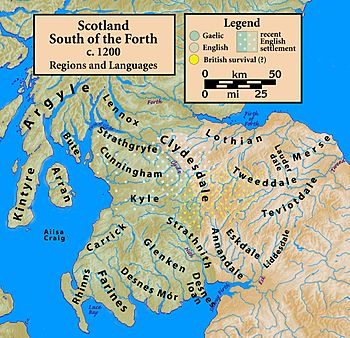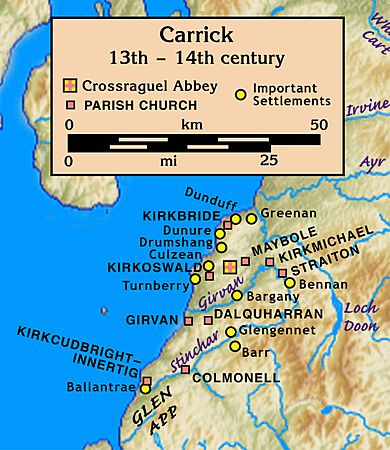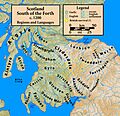Donnchadh, Earl of Carrick facts for kids
Quick facts for kids Donnchadh (Duncan) |
|
|---|---|
| Mormaer or Earl of Carrick | |
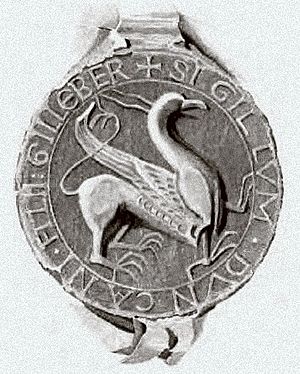
A 19th-century reproduction of an impression of Donnchadh's seal, surviving from a Melrose charter, depicting [according to antiquarian Henry Laing] a "winged dragon"; the inscription reads SIGILLUM DUNCANI FILII GILLEBER.. ("The seal of Donnchadh son of Gille-Brighde")
|
|
| Reign | c. 1186–1250 |
| Predecessor | Gille-Brighde mac Fergusa |
| Successor | Niall mac Donnchaidh |
| Born | mid-to-late 12th century location unknown, probably Galloway or Carrick |
| Died | 13 June 1250 unknown |
| Burial | unknown |
| Spouse | Avelina, daughter of Alan fitz Walter |
| Modern Gaelic | Donnchadh mac Ghille-Brìghde |
| Latin | Don[n]ecanus or Dun[e]canus filius Gilleberti |
| Norman French | Dunecan fitz Gilbert |
| Father | Gille-Brighde of Galloway |
| Mother | uncertain, but perhaps a daughter or sister of Donnchadh II, Earl of Fife |
Donnchadh (also known as Duncan) was an important Scottish leader from the late 1100s to the mid-1200s. He was a prince from the Gall-Gaidhil people, who lived in what is now south-western Scotland. His father, Gille-Brighde of Galloway, and his uncle, Uhtred of Galloway, were rival sons of Fergus of Galloway, the ruler of Galloway.
Because of conflicts between his father and uncle, and the Scottish King William the Lion, Donnchadh was sent to England as a hostage to King Henry II. He likely stayed there for about ten years. When his father died, Donnchadh returned to Scotland. Even though he didn't inherit all of Galloway, he was given control over the region of Carrick in the north. Donnchadh became the very first Earl of Carrick and ruled for over 60 years. His family line includes famous Scottish kings like the Bruce and Stewart families.
Contents
Who Was Donnchadh?
Donnchadh's life is known mostly from old official documents called charters and historical records from England and Scotland. These documents often mention his gifts to churches and monasteries. They also give us clues about his family and important events. For example, we know he was a hostage in England and that he fought battles in Ireland.
Where Donnchadh Lived
Donnchadh's home, Carrick, was in the south-west of Scotland. This area was a mix of different cultures and languages in the 1100s.
- Gaelic Speakers: The people in Donnchadh's area were called Gall-Gaidhil, which means "Foreign Gaels." They spoke a form of Gaelic.
- English Speakers: East of Carrick, in places like Lothian, people spoke English.
- Other Languages: Some areas also had people who spoke an old British language, though it was fading away.
Carrick was located near the Firth of Clyde and the Irish Sea. It was separated from other parts of Scotland by rivers and hills. The land was mostly hilly, so people raised animals more than they grew crops. The people of Carrick were organized into family groups led by "captains." Donnchadh, as the Earl, was the main "kin-captain" of Carrick.
Donnchadh's Family Tree
Donnchadh was the son of Gille-Brighde, who was the son of Fergus, the King of the Gall-Gaidhil. We don't know much more about Fergus's ancestors.
Historians believe Donnchadh's mother might have been a daughter or sister of Donnchadh II, Earl of Fife. This connection is suggested because Donnchadh was involved with the Cistercian nunnery of North Berwick, which was founded by the Fife family. Also, Donnchadh's own name was common in the Fife family.
Donnchadh had at least two known brothers. One was Máel Coluim, who led forces against their uncle Uhtred in 1174. Another brother, Gille-Chonaill Manntach, was mentioned in a document from 1233.
Hostage and Return to Power
In 1160, the Scottish King Máel Coluim mac Eanric (Malcolm IV) took control of Galloway and forced Donnchadh's grandfather, Fergus, to retire. For a while, Donnchadh's father Gille-Brighde and uncle Uhtred shared power under the Scottish king.
In 1174, when the Scottish King William the Lion was captured by the English, Gille-Brighde and Uhtred rebelled. They then fought each other, and Donnchadh's father won.
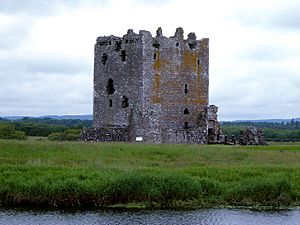
Gille-Brighde then tried to become a direct subject of King Henry II of England. In 1176, they made a deal: Gille-Brighde would pay Henry money and give his son Donnchadh as a hostage. Donnchadh was placed under the care of Hugh de Morwic, the sheriff of Cumberland. This agreement likely meant Donnchadh would inherit his father's lands.
When Gille-Brighde died in 1185, Donnchadh's cousin Lochlann tried to take over western Galloway, even though Donnchadh was still a hostage. King Henry II didn't like this, as it went against his agreement. Henry ordered the Scottish king to deal with Lochlann. Eventually, Lochlann was allowed to keep his father's lands, but Donnchadh's claim to his father's lands was to be decided in Henry's court.
Becoming Earl of Carrick
Although there's no record of a court hearing, Donnchadh was granted Carrick. This happened with the help of King William of Scotland. Donnchadh gained control of some of his father's lands in the west, which became the "earldom" of Carrick.
It's debated exactly when Donnchadh started using the title of Earl (or comes in Latin, mormaer in Gaelic). Some records suggest it was around 1214-1216, while others indicate he was using the title as early as 1196. Regardless, he was the first known Earl of Carrick.
Supporting the Church
Donnchadh was a generous supporter of religious groups.
- Melrose Abbey: Around 1200, he allowed the monks of Melrose Abbey to use saltpans from his land. He also gave them the church of Maybole and other lands.
- North Berwick Nunnery: He supported the North Berwick priory nunnery, which was founded by his probable grandfather. He gave them churches and money.
- Crossraguel Abbey: Donnchadh's most important gift was to the Cluniac Abbey of Paisley. He gave them land at Crossraguel with the condition that they build a monastery there.

However, the Paisley Abbey didn't build the monastery right away. It took many years and interventions from the Bishop of Glasgow and even the Pope before Crossraguel Abbey was finally founded around 1270, about two decades after Donnchadh's death.
Connections to Ireland
Donnchadh also had interests in Ireland. His cousin Affrica married John de Courcy, an Anglo-Norman lord who conquered parts of north-eastern Ireland. This marriage connected Donnchadh and other Gall-Gaidhil princes to Irish affairs.
Donnchadh helped John de Courcy in battles in Ireland. After King John of England campaigned in Ireland in 1210, Donnchadh was given control of a large area in County Antrim, including Larne and Glenarm. This was a reward for his help. His cousins also received large lordships in Ireland.
However, Donnchadh later lost these lands. In 1219, he and his nephew were dispossessed because they were wrongly accused of conspiring against the king. Even though King Henry III ordered their lands to be returned, it's unlikely Donnchadh ever got them back.
Death and Legacy
Donnchadh died on June 13, 1250. He was succeeded as Earl of Carrick by Niall. While it was traditionally thought Niall was Donnchadh's son, more recent research suggests Niall was actually Donnchadh's grandson. Donnchadh's son, Cailean, likely died before his father.
Donnchadh's probable grandson, Niall, was Earl for only six years. He had no sons, but four daughters. His eldest daughter, Marjorie, married Robert de Brus, 6th Lord of Annandale. Their son, Robert the Bruce, later became King of Scots, one of Scotland's most famous monarchs.
The title of Earl of Carrick became a special title for the king's son or heir. Donnchadh's family also passed down the title of Cenn Cineoil ("head of the kindred"), which meant they could lead the men of Carrick in war. This helped the family keep strong local leadership even when the main earldom passed to other families.
Donnchadh is also believed to be the great-grandfather of Cailean Mór, an important ancestor of the Campbell family, who later became the Dukes of Argyll. This connection explains why the names Donnchadh (Duncan) and Cailean (Colin) became popular among the Campbells.
Images for kids
-
A 19th-century reproduction of an impression of Donnchadh's seal, surviving from a Melrose charter, depicting [according to antiquarian Henry Laing] a "winged dragon"; the inscription reads SIGILLUM DUNCANI FILII GILLEBER.. ("The seal of Donnchadh son of Gille-Brighde")
-
The Island of Dee, now the location of the late medieval Threave Castle, viewed from the south-east; it was probably this island that Uhtred retreated to when he was besieged by Donnchadh's brother Máel Coluim.
-
James A. Morris' illustration of how the Cluniac Abbey of Crosssraguel roughly looked before its destruction in the early modern era


